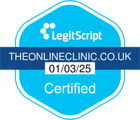Zindaclin gel
Zindaclin gel is for the treatment of acne (spots or pimples).
Can I buy Zindaclin online?
The Online Clinic can prescribe Zindaclin online following a quick consultation with a doctor. Simply complete the online consultation form, which will be reviewed by one of our GPs. The medication will be sent for next day delivery.
What is Zindaclin gel?
This medicine is known as Zindaclin 1% gel. Zindaclin gel contains clindamycin phosphate, which is the active ingredient that clears up spots. The white clear gel comes in a screw-cap tube containing 1.2% clindamycin phosphate that is equivalent to 1% clindamycin. One gram of gel contains approximately 0.2 g of alcohol.
Acne is a skin condition that is characterised by blackheads, whiteheads, and spots filled with pus. It normally occurs on the face, chest, shoulders, and upper back. Acne is a very common condition that differs in severity from a few facial spots to a widespread embarrassing problem. It usually starts during puberty but may occur at any age.
Pores on the skin's surface lead to a follicle channel each of which contain a hair and a sebaceous gland (other skin pores are sweat gland openings and not generally associated with acne). Acne occurs when the sebaceous glands that produce oil (grease) in the skin are more sensitive to normal concentrations of the hormone testosterone in the blood. This results in the sebaceous glands producing excess oil. Alongside this, dead skin cells are not properly shed blocking the skin's pores. Together, the dead skin cell and extra oil result in blackheads and whiteheads within the follicle.
Bacteria that cause acne live on the skin of every person. They normally do not cause a problem but excess oil and skin cells in clogged hair follicles provides the ideal living conditions for them to multiply. The blocked follicles then become inflamed, and red and pus-containing spots appear.
Zindaclin gel is an antibiotic medicine. It works by reducing the number of bacteria on the skin, preventing the skin pores from becoming blocked and causing new spots to appear. Zindaclin gel can also reduce the redness and inflammation of the spots that are already there.
How to use Zindaclin gel
Zindaclin gel is applied to the skin's surface only. It is applied once a day to clean and dry skin. The tube cap is removed and a small amount of gel is squeezed onto your finger. A thin layer is then spread over the skin area where spots usually appear. A thick layer will not work quicker or better. Ensure you put the cap back on after use. It is important to note that Zindaclin gel is not a spot-preventative measure. It is not for skin areas that do not get spots or to be dabbed on individual spots.
Zindaclin gel does not work rapidly and it may take a few weeks to see any improvement. Thereafter, improvement will be gradual with maximum effect seen after several months. More than one Zindaclin gel tube may be required during this time, and use should continue until your doctor tells you to stop.
If you get any gel in your eyes, nose or mouth, immediately wash them with lots of water. It is not of major concern if you apply too much Zindaclin gel, although the skin should be washed with lots of water. Neither is forgetting a dose - just apply the usual dose (not a double dose) when you remember and continue to use as prescribed.
Who can use Zindaclin gel?
All people over 12 years of age can be prescribed Zindaclin gel, if they are not allergic to clindamycin phosphate or any other of the gel's ingredients or to the antibiotic lincomycin. Women who are pregnant, could be pregnant, planning pregnancy, or breastfeeding must seek advice before using all medicines for the safety of the unborn baby.
You must tell your doctor if you have inflammatory bowel disease, have experienced diarrhoea when taking antibiotics, or while using Zindaclin gel when you must stop applying it and consult a doctor. The doctor must also be told about all medicines that you currently take, have recently taken, or take without a prescription.
Zindaclin gel side effects
Zindaclin gel generally affects the skin, commonly causing it to become dry, red, itchy, burn, or worsen the acne. Less commonly, the skin becomes painful or develops a scaly rash. These effects can usually be relieved by applying a moisturiser that is oil free to the affected skin area. Extremely rarely, inflammation of the bowel with diarrhoea containing blood and mucus occurs and treatment must be stopped.
GMC registration number: 4524038

Date: 23 January 2024
Next review: 22 January 2026
All UK registered doctors can have their registration checked on
The Medical Register at the GMC website.







